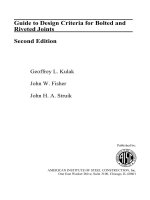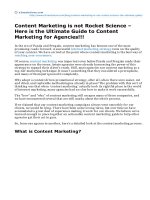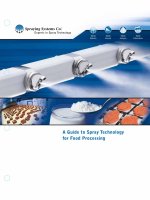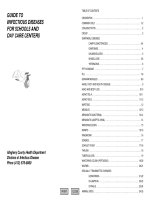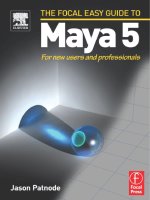Guide to Fluorine NMR for Organic Chemists William R. Dolbier(auth.)
Bạn đang xem bản rút gọn của tài liệu. Xem và tải ngay bản đầy đủ của tài liệu tại đây (6.56 MB, 264 trang )
GUIDE TO FLUORINE
NMR FOR ORGANIC
CHEMISTS
GUIDE TO FLUORINE
NMR FOR ORGANIC
CHEMISTS
WILLIAM R. DOLBIER, JR.
A JOHN WILEY & SONS, INC., PUBLICATION
Copyright © 2009 by John Wiley & Sons, Inc. All rights reserved.
Published by John Wiley & Sons, Inc., Hoboken, New Jersey.
Published simultaneously in Canada.
No part of this publication may be reproduced, stored in a retrieval system, or transmitted in
any form or by any means, electronic, mechanical, photocopying, recording, scanning, or
otherwise, except as permitted under Section 107 or 108 of the 1976 United States Copyright
Act, without either the prior written permission of the Publisher, or authorization through
payment of the appropriate per-copy fee to the Copyright Clearance Center, Inc., 222
Rosewood Drive, Danvers, MA 01923, (978) 750-8400, fax (978) 750-4470, or on the web at
www.copyright.com. Requests to the Publisher for permission should be addressed to the
Permissions Department, John Wiley & Sons, Inc., 111 River Street, Hoboken, NJ 07030, (201)
748-6011, fax (201) 748-6088, or online at />Limit of Liability/Disclaimer of Warranty: While the publisher and author have used their best
efforts in preparing this book, they make no representations of warranties with respect to the
accuracy or completeness of the contents of this book and specifically disclaim any implied
warranties of merchantability or fitness for a particular purpose. No warranty may be created
or extended by sales representatives or written sales materials. The advice and strategies
contained herein may not be suitable for your situation. You should consult with a professional
where appropriate. Neither the publisher nor author shall be liable for any loss of profit or any
other commercial damages, including but not limited to special, incidental, consequential, or
other damages.
For general information on our other products and services or for technical support, please
contact our Customer Care Department within the United States at (800) 762-2974, outside the
United States at (317) 572-3993 or fax (317) 572-4002.
Wiley also publishes its books in a variety of electronic formats. Some content that appears in
print may not be available in electronic formats. For more information about Wiley products,
visit our web site at www.wiley.com.
Library of Congress Cataloging-in-Publication Data
Dolbier, William R.
Guide to fluorine NMR for organic chemists / William R. Dolbier.
p. cm.
Includes index.
ISBN 978-0-470-19341-9 (cloth)
1. Fluorine compounds–Spectra. 2. Nuclear magnetic resonance spectroscopy. I. Title.
QD412.F1D65 2009
547′.02—dc22
2008053434
Printed in the United States of America.
10 9 8 7 6 5 4 3 2 1
CONTENTS
PREFACE
1
GENERAL INTRODUCTION
xiii
1
1.1. Why Fluorinated Compounds are Interesting / 1
1.1.1. Steric Size / 1
1.1.2. Polar Effects / 1
1.1.3. Effect of Fluorine Substituents on the Acidity
and Basicity of Compounds / 2
1.1.4. Effect of Fluorinated Substituents
on the Lipophilicity of Molecules / 3
1.1.5. Other Effects / 4
1.1.6. Analytical Applications in Biomedicinal
Chemistry / 4
1.2. Introduction to Fluorine NMR / 4
1.2.1. Chemical Shifts / 5
1.2.2. Coupling Constants / 6
References / 6
2 AN OVERVIEW OF FLUORINE NMR
2.1. Introduction / 9
2.2. Fluorine Chemical Shifts / 10
9
vi
CONTENTS
2.2.1.
2.2.2.
Steric Deshielding of Fluorine / 12
Solvent Effects on Fluorine Chemical
Shifts / 13
2.2.3. Overall Summary of Fluorine Chemical Shift
Ranges / 14
2.3. Spin-Spin Coupling Constants to Fluorine / 15
2.3.1. Through-Space Coupling / 18
2.3.2. Fluorine-Fluorine Coupling / 20
2.3.3. Coupling between Fluorine and Hydrogen / 20
2.3.4. Coupling between Fluorine and Carbon / 21
2.3.5. Second-Order Spectra / 22
2.4. 1H Spectra of Fluoroorganic Compounds / 27
2.5. 13C NMR Spectra of Fluoroorganic Compounds / 28
2.6. Isotope Effects on Chemical Shifts / 29
2.7. Advanced Topics / 31
2.7.1. Multidimensional 19F NMR / 32
References / 34
3
THE SINGLE FLUORINE SUBSTITUENT
3.1. Introduction / 35
3.1.1. Chemical Shifts—General Considerations / 36
3.1.2. Spin–Spin Coupling Constants—General
Considerations / 36
3.2. Saturated Hydrocarbons / 37
3.2.1. Primary Alkyl Fluorides / 37
3.2.2. Secondary Alkyl Fluorides / 40
3.2.3. Tertiary Alkyl Fluorides / 43
3.2.4. Cyclic Alkyl Fluorides / 45
3.3. Influence of Substituents/Functional Groups / 47
3.3.1. Halogen Substitution / 47
3.3.2. Alcohol, Ether, Ester, Sulfide, and Sulfone
Groups / 52
3.3.3. Amino and Ammonium Groups / 55
3.3.4. Phosphorous Compounds / 56
3.3.5. Silanes / 57
3.4. Carbonyl Functional Groups / 58
3.4.1. 1H and 13C NMR Data for Aldehydes, Ketones,
and Esters / 59
35
CONTENTS
vii
3.5. Nitriles / 60
3.5.1. 1H and 13C NMR Data for Nitriles / 61
3.6. Alkenes with a Single Fluorine Substituent / 61
3.6.1. Hydrocarbon Alkenes / 62
3.6.2. Conjugated Alkenyl Systems / 64
3.6.3. Allylic Alcohols, Ethers, and Halides / 67
3.6.4. Halofluoroalkenes and Fluorovinyl Ethers / 67
3.6.5. Multifluoroalkenes / 69
3.6.6. α,β-Unsaturated Carbonyl Compounds / 70
3.7. Acetylenic Fluorine / 75
3.8. Allylic, Propargylic, and Benzylic Fluorides / 75
3.8.1. 1H and 13C NMR Data / 75
3.9. Fluoroaromatics / 75
3.9.1. Monofluoroaromatics / 75
3.9.2. Fluoropolycyclic Aromatics:
Fluoronaphthalenes / 81
3.9.3. Polyfluoroaromatics / 82
3.10. Fluoroheterocycles / 83
3.10.1. Fluoropyridines and Quinolines / 88
3.10.2. Fluoropyrroles / 89
3.10.3. Fluorofurans and Benzofurans / 89
3.10.4. Fluorothiophene and Benzothiophene / 90
3.10.5. Fluoroimidazoles and Pyrazoles / 92
3.11. Other Common Groups with a Single Fluorine
Substituent / 92
3.11.1. Acyl Fluorides / 92
3.11.2. Fluoroformates / 94
3.11.3. Sulfinyl and Sulfonyl Fluorides / 94
References / 94
4
THE CF2 GROUP
4.1. Introduction / 97
4.1.1. Chemical Shifts—General Considerations / 98
4.1.2. Spin–Spin Coupling Constants—General
Considerations / 99
4.2. Saturated Hydrocarbons Containing a CF2 Group / 99
4.2.1. Alkanes Bearing a Primary CF2H Group / 100
4.2.2. Secondary CF2 Groups / 101
97
viii
CONTENTS
4.3.
4.4.
4.5.
4.6.
4.7.
4.8.
4.9.
4.2.3. Comments on Coupling Constants / 103
4.2.4. Pertinent 1H Chemical Shift Data / 105
4.2.5. Pertinent 13C NMR Data / 107
Influence of Substituents/Functional Groups / 108
4.3.1. Halogen Substitution / 109
4.3.2. Alcohol, Ether, Thioether, and Related
Substituents / 111
4.3.3. Compounds with Two Different Heteroatom
Groups Attached to CF2 Including
Chlorodifluoromethyl Ethers / 115
4.3.4. Amines, Phosphines, and Phosphonates / 116
4.3.5. Silanes / 118
4.3.6. Organometallics / 118
Carbonyl Functional Groups / 119
4.4.1. Aldehydes and Ketones / 119
4.4.2. Carboxylic Acids and Derivatives / 120
Nitriles / 122
4.5.1. 1H and 13C NMR Spectra of Nitriles / 122
Bifunctional CF2 Compounds / 123
Alkenes and Alkynes / 124
4.7.1. Simple Alkenes with Terminal Vinylic CF2
Groups / 124
4.7.2. Conjugated Alkenes with Terminal Vinylic CF2
Group / 126
4.7.3. Effect of Vicinal Halogen or Ether Function / 127
4.7.4. Polyfluoroethylenes / 127
4.7.5. The Trifluorovinyl Group / 127
4.7.6. α,β-Unsaturated Carbonyl Systems with a
Terminal Vinylic CF2 Group / 128
4.7.7. Allylic and Propargylic CF2 Groups / 129
Benzenoid Aromatics Bearing a CF2 Group / 130
4.8.1. 1H and 13C NMR Data / 131
Heteroaromatic CF2 Groups / 132
4.9.1. Pyridines / 132
4.9.2. Furans, Thiophenes, and Pyrroles / 132
4.9.3. Imidazoles and Other Heterocyclic CF2H
Compounds / 133
CONTENTS
ix
H and 13C NMR Data for Heterocyclic-Bound
CF2 Groups / 133
References / 135
4.9.4.
5
1
THE TRIFLUOROMETHYL GROUP
137
5.1. Introduction / 137
5.1.1. NMR Spectra of Compounds Containing the CF3
Group—General Considerations / 137
5.2. Saturated Hydrocarbons Bearing a CF3 Group / 139
5.2.1. Alkanes Bearing a CF3 Group / 139
5.2.2. Cycloalkanes Bearing a CF3 Group / 140
5.2.3. 1H and 13C NMR Data, General Information / 140
5.3. Influence of Substituents and Functional Groups / 142
5.3.1. Impact of Halogens / 143
5.3.2. Ethers, Alcohols, Esters, Sulfides, and
Selenides / 144
5.3.3. Amines and Phosphines / 148
5.3.4. Organometallics / 151
5.4. Carbonyl Compounds / 152
5.4.1. 1H and 13C NMR Data / 155
5.5. Nitriles / 157
5.5.1. 13C NMR Data for Nitriles / 157
5.6. Bifunctional Compounds / 158
5.7. Sulfonic Acid Derivatives / 158
5.8. Allylic and Propargylic Trifluoromethyl Groups / 159
5.8.1. Allylic Trifluoromethyl Groups / 159
5.8.2. α,β-Unsaturated Carbonyl Compounds / 163
5.8.3. More Heavily Fluorinated Allylics / 165
5.8.4. Propargylic Trifluoromethyl Groups / 165
5.9. Aryl-Bound Trifluoromethyl Groups / 166
5.9.1. 13C NMR Data / 167
5.10. Heteroaryl-Bound Trifluoromethyl Groups / 168
5.10.1. Pyridines and Quinolines / 168
5.10.2. Pyrroles and Indoles / 169
5.10.3. Thiophenes and Benzthiophenes / 170
5.10.4. Furans / 170
5.10.5. Imidazoles and Benzimidazoles / 172
x
CONTENTS
5.10.6. Oxazoles, Thiazoles, Benzoxazoles, and
Benzthiazoles / 173
5.10.7. Pyrazoles and Pyridazines / 174
References / 175
6
MORE HIGHLY FLUORINATED GROUPS
177
6.1. Introduction / 177
6.2. The 1,1,2- and 1,2,2-Trifluoroethyl Groups / 178
6.3. The 1,1,2,2-Tetrafluoroethyl and 2,2,3,3-Tetrafluoropropyl
Groups / 180
6.4. The 1,2,2,2-Tetrafluoroethyl Group / 183
6.5. The Pentafluoroethyl Group / 185
6.5.1. Pentafluoroethyl Carbinols / 188
6.5.2. Pentafluoroethyl Ethers and Sulfides / 188
6.5.3. Pentafluoroethyl Organometallics / 189
6.6. The 2,2,3,3,3-Pentafluoropropyl Group / 189
6.7. The 1,1,2,3,3,3-Hexafluoropropyl Group / 192
6.8. The Hexafluoro-iso-Propyl Group / 192
6.9. The Heptafluoro-n-Propyl Group / 194
6.10. The Heptafluoro-iso-Propyl Group / 195
6.11. The Nonafluoro-n-Butyl Group / 195
6.12. Fluorous Groups / 195
6.13. 1-Hydro-Perfluoroalkanes / 197
6.14. Perfluoroalkanes / 197
6.15. Perfluoro-n-Alkyl Halides / 201
6.16. Perfluoroalkyl Amines, Ethers, and Carboxylic Acid
Derivatives / 201
6.17. Polyfluoroalkenes / 201
6.17.1. Trifluorovinyl Groups / 201
6.17.2. Perfluoroalkenes / 205
6.18. Polyfluorinated Aromatics / 206
6.18.1. 2,3,5,6-Tetrafluorobenzene Compounds / 206
6.18.2. The Pentafluorophenyl Group / 206
6.19. Polyfluoroheterocyclics / 207
6.19.1. Polyfluoropyridines / 207
6.19.2. Polyfluorofurans / 207
CONTENTS
xi
6.19.3. Polyfluorothiophenes / 207
6.19.4. Polyfluoropyrimidines / 207
References / 210
7
COMPOUNDS AND SUBSTITUENTS WITH
FLUORIDE DIRECTLY BOUND TO A HETEROATOM
211
7.1.
7.2.
7.3.
7.4.
Introduction / 211
Boron Fluorides / 212
Fluorosilanes / 213
Nitrogen Fluorides / 213
7.4.1. Electrophilic Fluorinating Agents / 214
7.5. Phosphorous Fluorides / 214
7.5.1. Phosphorous (III) Fluorides / 214
7.5.2. Phosphorous (V) Fluorides / 215
7.5.3. Phosphorous (V) Oxyfluorides / 217
7.6. Oxygen Fluorides (Hypofluorites) / 217
7.7. Sulfur Fluorides / 218
7.7.1. Inorganic Sulfur Fluorides and Oxyfluorides / 218
7.7.2. Aryl and Alkyl SF3 Compounds / 219
7.7.3. Dialkylaminosulfur Trifluorides / 219
7.7.4. Hypervalent Sulfur Fluorides / 221
7.7.5. Related Hypervalent Selenium and Tellurium
Fluorides / 221
7.7.6. Organic Sulfinyl and Sulfonyl Fluorides / 222
7.8. The Pentafluorosulfanyl (SF5) Group / 222
7.8.1. Saturated Aliphatic Systems / 225
7.8.2. Vinylic SF5 Substituents / 228
7.8.3. Acetylenic SF5 Substituents / 229
7.8.4. Aromatic SF5 Substituents / 229
7.9. Bromine Trifluoride and Iodine Pentafluoride / 230
7.10. Aryl Halogen Difluorides and Tetrafluorides / 231
7.11. Xenon Difluoride / 231
References / 232
GENERAL INDEX
233
COMPOUND INDEX
236
PREFACE
Fluorine’s unique polar and steric properties as a substituent, and the
influence that fluorinated substituents can have upon the physical and
chemical properties of molecules, have induced increasing numbers of
synthetic organic chemists to incorporate fluorine into target compounds of synthetic interest. In preparing compounds that contain
fluorine, one first faces the daunting task of learning the intricacies of
fluorine’s often unique synthetic methodologies.
Then, once the desired fluorine-containing compounds have been
synthesized, the real fun begins as the world of fluorine NMR is entered.
However, one’s first encounter with fluorine NMR can also present a
problem because although most synthetic organic chemists are thoroughly familiar with the use of proton and carbon NMR for compound
characterization, few have much experience with the use of fluorine
NMR for that purpose. Moreover, there is presently no single place
where a person can turn to obtain a concise but thorough introduction
to fluorine NMR itself and, just as importantly, to learn how the presence of fluorine substituents can enhance the efficacy of both proton
and carbon NMR as tools for structure characterization.
Simply speaking, the purpose of this little book is to provide you, the
working organic chemist, with virtually everything you need to know
about fluorine NMR, including an understanding of the impact of fluorine substituents upon proton and carbon NMR.
This book is primarily intended for use by academic and industrial
organic chemists, most of whom will have interests in fluorinated
xiv
PREFACE
compounds of potential pharmaceutical and agrochemical interest.
Such compounds are for the most part what I will call “lightly” fluorinated, that is, containing one or at most a few fluorine-containing substituents, with the emphasis being on isolated fluorine substituents, CF2
groups, and trifluoromethyl substituents. However, virtually all fluorine-containing substituents that might be of interest, including C2F5
and SF5, will be discussed. More heavily fluorinated compounds will
not be totally ignored, but the emphasis will be upon the lightly fluorinated species.
Hopefully, this book will work both to provide an introduction to
the novice and as a resource for those chemists who are more experienced in working with fluoro-organic compounds. As you will soon
notice, the book has not been written by an NMR “specialist,” but
rather has been written for working organic chemists by a working
organic chemist.
This book would not have been possible without the encouragement
of my wife, Jing, the critical technical assistance of Dr. Ion Ghiviriga in
obtaining and interpreting NMR spectra, and the able assistance of my
current and past research group members who synthesized key model
compounds and who, along with Dr. Ghiviriga, obtained all spectra that
appear in this book. They include Dr. Ying Chang, Dr. Wei Xu, Lianhao
Zhang, and Henry Martinez.
William R. Dolbier, Jr.
CHAPTER 1
GENERAL INTRODUCTION
1.1. WHY FLUORINATED COMPOUNDS ARE INTERESTING
The reason that organic chemists are interested in compounds that
contain fluorine is simple. Because of fluorine’s steric and polar characteristics, even a single fluorine substituent, placed at a propitious position within a molecule, can have a remarkable effect upon the physical
and chemical properties of that molecule. Discussions of the impact
of fluorine on physical and chemical properties of compounds have
appeared in numerous reviews and textbooks.1–8 There are also a number
of recent reviews on the subject of fluorine in medicinal chemistry.9–13
1.1.1. Steric Size
In terms of its steric impact, fluorine is the smallest substituent that
can replace a hydrogen in a molecule, other than an isotope of hydrogen. Table 1.1 provides insight as to the comparative steric impact of
various fluorinated substituents on the equilibrium between axial and
equatorial substitution in cyclohexane.14
1.1.2. Polar Effects
Fluorine is, of course, the most electronegative atom on the periodic
table. σp and F values (the “pure” field inductive effect) provide
Guide to Fluorine NMR for Organic Chemists, by William R. Dolbier, Jr.
Copyright © 2009 by John Wiley & Sons, Inc.
1
2
GENERAL INTRODUCTION
TABLE 1.1. A Values of Some Common Substituents
X
X
–ΔG° (kcal/mol–1) = A value
X
A value
X
A value
[0]
0.5
0.6
1.7
1.8
2.2
2.8
F
OCF3
SCF3
CH2F
CHF2
CF3
C2F5
0.2
0.8
1.2
1.6
1.9
2.4
2.7
H
OH
OCH3
CH3
C2H5
i-C3H7
Ph
TABLE 1.2. Substituent Effects: σP and F Values
Substituent
H
F
Cl
OH
NH2
NO2
CH3
σp
F
Substituent
σp
F
[0]
0.06
0.23
−0.37
−0.66
0.78
−0.17
[0]
0.45
0.42
0.33
0.08
0.65
0.01
CH2F
CHF2
CF3
C2F5
OCF3
SCF3
SF5
CH2CF3
0.11
0.32
0.54
0.52
0.35
0.50
0.68
0.09
0.15
0.29
0.38
0.44
0.39
0.36
0.56
0.15
indications of the electron-withdrawing influence of substituents, and
it can be seen that fluorine itself has the largest F value of an atomic
substituent. The values for σP and F for various other fluorinated
(and nonfluorinated) substituents provide insight into the relative
electron-withdrawing power of fluorinated substituents (Table 1.2).15
1.1.3. Effect of Fluorine Substituents on the Acidity and
Basicity of Compounds
The strong electronegativity of the fluorinated substituents is reflected
in the effect that this group has upon the acidity of alcohols and
carboxylic acids, as well as the effect it has on the basicity of amines
(Tables 1.3–1.5).
WHY FLUORINATED COMPOUNDS ARE INTERESTING
3
TABLE 1.3. Carboxylic Acid Acidity1,2
XCH2CO2H
pKa
X=H
X=F
X = NO2
X = CF3
X = CF3CH2
CF3CO2H
4.8
2.6
1.5
2.9
4.2
0.2
TABLE 1.4. Alcohol Acidity1,2,6
Alcohol
pKa
CH3CH2OH
CF3CH2OH
15.9
12.4
(CF3)2CHOH
9.3
(CF3)3COH
5.4
TABLE 1.5. Amine Basicity1
XCH2NH2
pKb
X = CH3
X = CH2CF3
X = CF3
3.3
5.3
8.3
1.1.4. Effect of Fluorinated Substituents
on the Lipophilicity of Molecules
Lipophilicity is an important consideration in the design of biologically
active compounds because it often controls absorption, transport, or
receptor binding; that is, it is a property that can enhance the bioavailability of a compound. The presence of fluorine in a substituent gives
rise to enhanced lipophilicity.
For substituents on benzene, lipophilicities are given by values of πX,
as measured by the following equation (Scheme 1.1), where P values
are the octanol/water partition coefficients.
Representative π values
CH 3 ( 0.56), CF3 ( 0.88), OCF3 (1.04), SF5 (1.23), SCF3 (1.44)
As a measure of the impact of fluorine on a molecule’s lipophilicity,
the π value of a CF3 group is 0.88, as compared to 0.56 for a CH3 group.
4
GENERAL INTRODUCTION
Scheme 1.1
πX = log PC6H5X – log PC6H6
SO2CH3 < OH < NO2 < OCH3 < H < F < Cl < SO2CF3 < CH3 < SCH3 < CF3 < OCF3
< SF5 < SCF3 < C2F5
1.1.5. Other Effects
There is also evidence that single, carbon-bound fluorine substituents,
particularly when on an aromatic ring, can exhibit specific polarity
influences, including H-bonding, that can strongly influence binding to
enzymes.9
These and other insights regarding structure–activity relationships for fluorinated organic compounds allow researchers interested in exploiting the effects of fluorine substitution on bioactivity
to more effectively design fluorine-containing bioactive compounds.
In the process of the synthesis of such compounds, it is necessary to
characterize the fluorine-containing synthetic intermediates and
ultimate target compounds. Knowledge of 19F NMR is essential for
such characterization.
1.1.6. Analytical Applications in Biomedicinal Chemistry
Over the past decade or so, NMR spectroscopy has emerged as a
screening tool to facilitate the drug discovery process, and nowhere
has this been more the case than with 19F NMR spectroscopy (more
about this in Chapter 2).
1.2. INTRODUCTION TO FLUORINE NMR16
Aside from carbon and hydrogen, 19F is probably the most studied
nucleus in NMR. The reasons for this include both the properties of
the fluorine nucleus and the importance of molecules containing fluorine. The nucleus 19F has the advantage of 100 % natural abundance
and a high magnetogyric ratio, about 0.94 times that of 1H. The chemical shift range is very large compared to that of hydrogen, encompassing a range of >350 ppm for organofluorine compounds. Thus, resonances
of different fluorine nuclei in a multifluorine-containing compound
INTRODUCTION TO FLUORINE NMR
5
are usually well separated and the spectra usually first order. The
nuclear spin quantum number for fluorine is 21 and thus fluorine
couples to proximate protons and carbons in a manner similar to
hydrogen, and relaxation times are sufficiently long for spin–spin splittings to be resolved. Moreover, long-range spin–spin coupling constants
to fluorine can have substantial magnitude, which can be particularly
useful in providing extensive connectivity information, especially in 13C
NMR spectra.
1.2.1. Chemical Shifts
Fluorotrichloromethane (CFCl3) has become the accepted, preferred
internal reference for the measurement of 19F NMR spectra, and, as
such, it is assigned a shift of zero. Signals upfield of the CFCl3 peak are
assigned negative chemical shift values, whereas those downfield of
CFCl3 are assigned positive values for their chemical shifts. When
reporting fluorine chemical shifts, it is advised to report them relative
to CFCl3.
Other compounds that are commonly encountered as internal
standards, particularly in the earlier literature, are
CF3CO2H: −76.2 ppm
Hexafluorobenzene: −162.2 ppm
Trifluoromethylbenzene: −63.2 ppm
Ethyl trifluoroacetate: −75.8 ppm
However, CFCl3 has the advantage that its presence will not have
any influence upon a compound’s chemical shifts, plus its observed
signal lies substantially downfield of most signals deriving from carbonbound fluorine. Therefore, most fluorine chemical shifts (δ) are negative
in value.
Nevertheless, one must be aware that some significant fluorinecontaining functional groups, such as acylfluorides (∼+20 ppm), sulfonylfluorides (δ ∼+60), pentafluorosulfanyl (SF5) substituents (up to
+85 ppm) have signals in the region downfield from CFCl3. Signals
deriving from aliphatic CH2F groups lie at the high field end of the
range, with n-alkyl fluorides absorbing at about −218 ppm. Methyl fluoride has the highest field chemical shift for an organofluorine compound at −268 ppm. Chapter 2 will provide an overview of fluorine
chemical shifts, with subsequent chapters providing details for each
type of fluorinated substituent.
6
GENERAL INTRODUCTION
All chemical shift data presented in this book come either from the
primary literature or from spectra obtained in the author’s laboratory.
All spectra actually depicted in the book derive from spectra obtained
by the author at the University of Florida. All data from the literature
were obtained via searches using MDL Crossfire Commander or
SciFinder Scholar. Persons interested in accessing such primary literature can do so readily via these databases by simply searching for the
specific compound mentioned in the text.
It should be noted that there is some variation in reported chemical
shifts for particular compounds in the literature, as would be expected.
Usually, these variations are less than ±2 ppm, and they can usually be
attributed to concentration and solvent effects (as well as simple experimental error!). When given a choice, data reported using CDCl3 as
solvent will be preferred, with chemical shifts being reported to the
nearest parts per million (except occasionally when comparisons within
a series from a common study are reported). When multiple values
have been reported in the literature, the author will use his judgment
regarding choice of the value to use in the book.
1.2.2. Coupling Constants
Fluorine spin–spin coupling constants to other fluorine nuclei, to neighboring hydrogen nuclei, and to carbons in the vicinity of the fluorine
substituents are highly variable in magnitude but are also highly characteristic of their environment. The magnitude of such characteristic
coupling constants will be discussed in each of the subsequent chapters
that describe the different structural situations of fluorine substitution.
Spin–spin coupling constants will be reported throughout this book
as absolute values of |J| in hertz, and they have all been obtained either
from the primary literature or from spectra obtained in the author’s
laboratory.
REFERENCES
Regarding the multitude of NMR chemical shifts of specific compounds that
are provided within the text, references for chemical shifts of individual compounds for the most part will not be cited. It is assumed that if such references
are required, the reader can find them by a quick search using either MDL
Crossfire Commander or SciFinder Scholar. The author found MDL Crossfire
Commander the superior database for locating specific NMR data.
REFERENCES
7
1. Chambers, R. D. Fluorine in Organic Chemistry; John Wiley & Sons: New
York, 1973.
2. Uneyama, K. Organofluorine Chemistry; Blackwell Publishing: Oxford,
2006, 339 p.
3. Hiyama, T. Organofluorine Compounds. Chemistry and Applications;
Springer: Berlin, 2000, 272 p.
4. Welch, J. T.; Eswarakrishnan, S. Fluorine in Bioorganic Chemistry; John
Wiley & Sons: New York, 1991, 261 p.
5. Begue, J.-P.; Bonnet-Delpon, D. Chimie Bioorganique et Medicinale du
Fluor; EDP Sciences: Paris, 2005, 366 p.
6. Smart, B. E. In Organofluorine Chemistry—Principles and Commercial
Applications; Banks, R. E.; Smart, B. E.; Tatlow, J. C.; Eds.; Plenum Press:
New York, 1994, 57–88.
7. O’Hagan, D. Chem. Soc. Rev. 2008, 37, 308–319.
8. Kirsch, P. Modern Fluoroorganic Chemistry; Wiley-VCH: Weinheim, 2004,
308 p.
9. Purser, S.; Moore, P. R.; Swallow, S.; Gouverneur, V. Chem. Soc. Rev. 2008,
37, 320–330.
10. Kirk, K. L. Org. Proc. Res. Dev. 2008, 12, 305–321.
11. Isanbor, C.; O’Hagan, D. J. Fluorine Chem. 2006, 127, 303–319.
12. Begue, J.-P.; Bonnet-Delpon, D. J. Fluorine Chem. 2006, 127, 992–1012.
13. Kirk, K. L. J. Fluorine Chem. 2006, 127, 1013–1029.
14. Carcenac, Y.; Tordeux, M.; Wakselman, C.; Diter, P. New J. Chem. 2006, 30,
447–457.
15. Hansch, C.; Leo, A.; Taft, R. W. Chem. Rev. 1991, 91, 165–195.
16. Hesse, M.; Meier, H.; Zeeh, B. Spectroscopic Methods in Organic Chemistry;
Georg Thieme Verlag: Stuttgart, 1997, 365 p.
CHAPTER 2
AN OVERVIEW OF FLUORINE NMR
2.1. INTRODUCTION
If one wishes to obtain a fluorine NMR spectrum, one must of course
first have access to a spectrometer with a probe that will allow observation of fluorine nuclei. Fortunately, most modern high field NMR spectrometers that are available in industrial and academic research
laboratories today have this capability. Probably the most common
NMR spectrometers in use today for taking routine NMR spectra are
300 MHz instruments, which measure proton spectra at 300 MHz,
carbon spectra at 75.5 MHz and fluorine spectra at 282 MHz. Before
obtaining and attempting to interpret fluorine NMR spectra, it would
be advisable to become familiar with some of the fundamental concepts
related to fluorine chemical shifts and spin-spin coupling constants that
are presented in this book. There is also a very nice introduction to
fluorine NMR by W. S. and M. L. Brey in the Encyclopedia of Nuclear
Magnetic Resonance.1
For those new to the field of fluorine NMR, there are a number of
convenient aspects about fluorine NMR that make the transition from
proton NMR to fluorine NMR relatively easy. With a nuclear spin of 21
and having almost equal sensitivity to hydrogen along with sufficiently
long relaxation times to provide reliable integration values, 19F nuclei
Guide to Fluorine NMR for Organic Chemists, by William R. Dolbier, Jr.
Copyright © 2009 by John Wiley & Sons, Inc.
9
10
AN OVERVIEW OF FLUORINE NMR
provide NMR spectra that very much resemble proton spectra, with the
additional benefit of having a much broader range of chemical shifts,
which means that one usually will not encounter overlapping signals in
compounds that contain multiple fluorine-containing substituents, and
thus most spectra will be first order. Also, since it is not usual to employ
proton decoupling when obtaining fluorine NMR spectra, one will
observe not only coupling between proximate fluorine substituents, but
also between fluorine nuclei and proton nuclei, with the magnitude of
geminal and vicinal F–F and F–H coupling constants generally being
larger than the respective H–H spin-spin coupling constants.
As is the case for 1H spectra, but not for 13C spectra, the intensities
of individual signals in 19F NMR spectra constitute an accurate measure
of the relative number of fluorine atoms responsible for such signals.
Because today the majority of organic chemists who make fluoroorganic compounds work in pharmaceutical and agrochemical industries,
and such people are primarily interested in lightly fluorinated molecules, the emphasis in this book will be the NMR analysis of compounds
containing one, two or three fluorine atoms or bearing substituents
containing a limited number of fluorines, with the goal of understanding
how the chemical shifts and spin-spin couplings of such substituents are
affected by the structural environment in which they exist.
2.2. FLUORINE CHEMICAL SHIFTS
The observed resonance frequency of any NMR-active nucleus depends
in a characteristic manner upon the magnetic environment of that
nucleus. The effective field strength (Beff) felt by the nucleus of an atom
that has magnetic moment differs from the imposed field (B0) in the
following manner (eq. 2.1)
Beff = B0 − σB0
(2.1)
where σ is the dimensionless shielding constant
This shielding constant, σ, is made up of three terms (eq. 2.2)
σ = σ dia + σ para + σ i
(2.2)
The diamagnetic term, σdia, corresponds to the opposing field resulting from the effect of the imposed field upon the electron cloud surrounding the nucleus. In this case, electrons closer to the nucleus give
rise to greater shielding than distant ones.
FLUORINE CHEMICAL SHIFTS
11
The paramagnetic term, σpara, derives from the excitation of p-electrons by the external field, and its impact is opposite to that of diamagnetic shielding. The term, σi, derives from the effect of neighboring
groups, which can increase or decrease the field at the nucleus. σ can
also be affected by intermolecular effects, in most cases deriving from
interaction of the solvent.
In the case of proton spectra, only s-orbitals are present. Thus, only
σdia is important, whereas, in contrast, the paramagnetic term, σpara, is
dominant in determining the relative shielding of fluorine nuclei. Thus,
the “normal” intuitions regarding “shielding” that most chemists have
acquired while working with 1H NMR generally do not apply when it
comes to predicting relative chemical shifts in 19F NMR. For example,
the fluorine nucleus of ClCH2CH2F is slightly more highly shielded
(δF = −220) than that of CH3CH2F (δF = −212).
There are other notable differences between fluorine and proton
NMR spectra. For example, the effects of anisotropic magnetic fields,
such as those generated by ring currents, are relatively much less important for fluorine than for proton NMR. Thus the ranges of vinylic and
aromatic fluorine chemical shifts overlap completely. Also notable is
the much greater sensitivity of single carbon-bound F-substituents to
environment than carbon-bound CF2 or CF3 substituents. Single fluorine chemical shifts, which encompass vinylic, aryl, and saturated
aliphatic fluorine substituents, range between about −70 ppm and
−238 ppm, whereas the similar range for CF2 groups is −80 to −130 ppm,
and that of the CF3 group is even smaller, between about −52 and
−87 ppm.
In general, and all other things being equal, the fluorines of a trifluoromethyl group are more deshielded than those of a CF2H or
R–CF2–R′ group, which are themselves more deshielded than a single
fluorine substituent (Scheme 2.1).
Scheme 2.1
CH2F
–219
CH2F
–206
CHF2
–116
CHF2
–115
CF3
–68
CF3
–63
12
AN OVERVIEW OF FLUORINE NMR
TABLE 2.1. Impact of α-Halogen Substitution on Fluorine Chemical Shifts
X
CH3
F
Cl
Br
I
δ, CF3X
δ, HCF2X
δ, H2CFX
−65
−110
−212
−62
−78
−143
−33
−73
−169
−21
−70
—
−5
−68
−191
TABLE 2.2. Impact of α-Chalcogen Substitution on Fluorine Chemical Shifts
Y
CF3Y, δ
HCF2Y, δ
H2CFY, δ
F
OPh
SPh
SePh
−62
−79
−143
−58
−87
−149
−43
−96
−180
−37
−94
—
Some illustrative trends in chemical shift exist for the effect of αhalogen or α-calcogen substitution on a fluorinated carbon. Trends in
chemical shift derived from α-halogen-substitution on CF3, CF2H, and
CH2F groups are variable, depending on the group, with CF3 and CF2H
being increasingly deshielded by F < Cl < Br < I (opposite the trend
observed for proton chemical shifts), with this trend being more pronounced for CF3. In contrast, the CH2F group is increasingly shielded
going from F to I (Table 2.1).
Likewise, the analogous α-chalcogen substitution only exhibits a
consistent deshielding trend for the CF3 group (F < OPh < SPh < SePh),
with shielding effects being observed for both the CF2H and CH2F
groups (Table 2.2).
2.2.1. Steric Deshielding of Fluorine
Another significant and not infrequently encountered impact on fluorine chemical shifts is the deshielding influence of a physically proximate alkyl group upon CF3 groups, CF2 groups, and aromatic C–F
(based upon limited data, there does not appear to be significant effect
on CH2F groups).2 Under circumstances such as those depicted in
Scheme 2.2 below, where structurally all other factors are equal except
for the steric interaction of the alkyl group with the fluorinated group,
one observes significant deshielding in the presence of this steric interaction. This deshielding is understood to occur only when there is direct
overlap of the van der Waals radii of the alkyl group and that of the
fluorine, and the deshielding is thought to be the result of van der Waals
forces of the alkyl group restricting the motion of electrons on the
fluorine and thus making the fluorine nucleus respond to the magnetic
field as if the electron density were lowered.
FLUORINE CHEMICAL SHIFTS
13
Scheme 2.2
δF
X
F
X=H
–124
X = CH3
–113
X = C2H5
–114
X = t-Bu
–96
C4H9 CF3
CF3
F
–59
F3C
–54
C4H9
C4H9
–65
H3C
F3C
–59
CF2CH3
–87
CF2CH3
CH3
–84
The most common situation where this effect is seen is in a comparison of E- and Z- isomers of trifluoromethyl- or difluoromethylsubstituted alkenes, but as the naphthalene examples indicate, the
effect is not unique to that situation.
2.2.2. Solvent Effects on Fluorine Chemical Shifts
There will usually not be much variation observed in fluorine chemical
shifts for the three most common solvents used for obtaining NMR
spectra, that is CDCl3, DMSO-d6, and acetone-d6, as can be seen in the
data presented in Table 2.3 for spectra of a series of typical fluorinecontaining compounds in various solvent. The variation in fluorine
chemicals shifts for these three solvents is no more than ±1 ppm. Thus,
in reporting chemical shifts in this book, no mention of specific solvent
will be made, although the vast majority of spectra will have been measured in CDCl3.
14
AN OVERVIEW OF FLUORINE NMR
TABLE 2.3. Solvent Effects on Fluorine Chemical Shifts
Compound
CDCl3
δ
DMSO-d6
δ
Acetone-d6
δ
Benzene-d6
δ
CD3OD
δ
CF3CHClBr
HCF2CF2CH2OH
−76.5
−139.2
−127.4
−113.6
−218.5
−75.1
−140.4
−127.1
−113.1
−216.8
−76.3
−141.1
−128.5
−114.2
−218.4
−76.6
−139.7
−127.8
−113.3
−218.2
−77.5
−141.8
−129.4
−115.2
−219.7
fluorobenzene
1-fluorooctane
TABLE 2.4. Solvent Effects on Proton Chemical Shifts
Compound
CDCl3
δ
Acetone-d6
δ
DMSO-d6
δ
Benzene-d6
δ
CD3OD
δ
5.82
5.93
3.98
7.30
7.07
4.42
6.16
6.28
3.95
7.40
7.15
4.42
6.08
6.89
4.25
7.40
7.20
4.42
4.63
5.34
3.29
6.88
6.78
4.12
5.77
6.12
3.86
7.33
7.09
4.44
CF3CHClBr
HCF2CF2CH2OH
fluorobenzene
1-fluorooctane
Larger solvent effects can be observed for proton spectra, particularly when using benzene-d6. As can be seen from the data in Table 2.4,
proton chemical shifts in the other solvents, particularly CDCl3 and
acetone-d6, are reasonably consistent.
2.2.3. Overall Summary of Fluorine Chemical Shift Ranges
Figure 2.1 provides a quick overview of the basic chemical shift
ranges for carbon-bound F, CF2, and CF3 substituents. Specific details
CF3-C
CF3-vinylic
C-CF2-C
CF3-aryl
C-CF2H
CF2=C
Alkyl-F
Ar-F
Vinylic-F
δ
0
–25
–50
–75
–100
–125
–150
–175
–200
–225
–250
–275 ppm
FIGURE 2.1. Overview of Fluorine Chemical Shifts (relative to CFCl3 (δ = 0))
